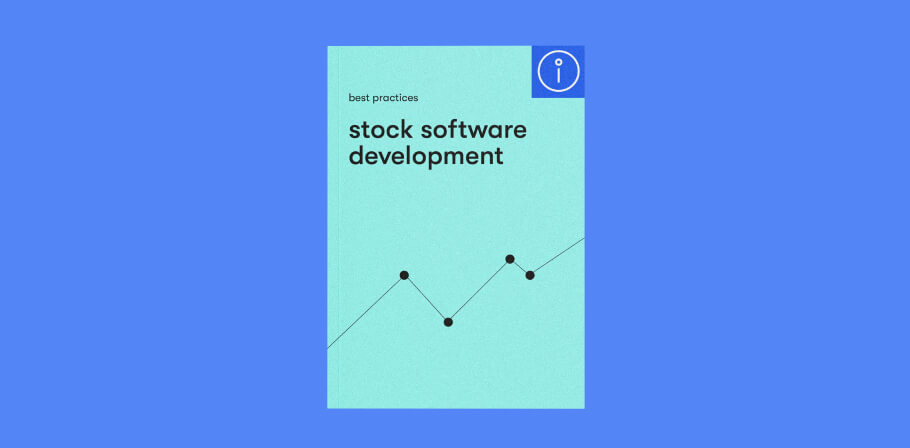For tech startups, creating an application involves a series of properly-curated operations that make up the software development process. By following the outlined strategy — and making well-timed, data-driven changes — you give your startup the best chance to scale and optimize gains.
Not only that, software vendors prefer working with startups because young businesses and entrepreneurs often have a robust approach to product development.
In this article, we’ll cover the peculiarities of the software development process for startups. We’ll also discuss the stages and models of product building that every tech startup should know and adopt.
Peculiarities of the Software Development Process for Startups
The general startup software development process is unique because small companies don’t have the same market authority and financial leverage as established corporations and businesses.
Here are the key differentiating factors:
Flexibility to adapt to changes
As a young business making its way into an established market, staying flexible is indispensable for survival. Every startup should have a business approach that adjusts to the market instead of entrenching itself into a fixed strategy.
Ability to pivot
Flexibility gives you the ability to make subtle adjustments to the business plan, but you also get more freedom to change your startup’s direction. The free-flowing nature of a good software development procedure for startups allows owners to pivot without incurring massive losses or failing completely.
Attention to user feedback
Unlike medium and large businesses with mountains of field experience, startups need to pay extra attention to customer feedback when strategizing for product development. Since startups have a smaller consumer pool compared to large enterprises, they can gather audience-specific, actionable insights from users directly.
Attention to data
Just like other aspects of your business, every process of developing software for a startup must rely on data. Although companies of different sizes rely on information from multiple sources, startups specifically have to build datasets for every product they develop. By doing so, they can avoid the accumulation of data silos — a common problem in large corporations.
Want to build a top-notch product? Reach out to us right away.
Phases of a Startup Software Development Process
When working on a new product, you need to follow a systematic path to ensure that the product life cycle flows smoothly from inception to deployment and beyond. Depending on your preference, you can remove, combine, or add steps to achieve your goal or meet the launch deadline.
Here are the core phases of the software development life cycle (SDLC).
1. Ideation
Your software development journey starts once an idea pops into your brain. For startups with many team members, ideation often involves brainstorming sessions during which participants share their ideas.
During these sessions, don’t disregard any opinion. Record every proposition and gather them into an “idea bank” for future reference. Then, through elimination and constructive criticism, deconstruct the suggestions to determine their validity.
Conducting market research also gives you better ideas by providing a clear view of the industry status quo as well as competitors. By carrying out a SWOT analysis of your competitors, you can spot their strengths and weaknesses. From the results, you can finalize the best approach for your startup.
2. Business validation
After coming up with a concept, the next step is to validate it with your partners, investors, and stakeholders. For this, you need a clear product concept that outlines the proposed business plan, direct and indirect competitors, and monetization strategies.
During this phase, you may also need to develop a minimum viable product (MVP), displaying the software solution’s base requirements and functionalities.
Note: Some startups develop the MVP in the design stage after validating the business plan. However, if you are seeking funding from government agencies or angel investors, you might need an MVP to prove that your vision is feasible.
3. Design
During the product building process for startups, your design team must develop a “portrait” of the software to help developers and engineers visualize the final product.
The design stage mashes up the finalized ideas with the business plan to come up with a tangible, realistic product. As mentioned above, your startup can develop the MVP during this stage.
Also, your UX/UI team can create wireframes and prototypes displaying how the application’s user interface responds to interactions. Afterward, the engineers will determine the feasibility of the features in the prototype before they start building the product.
4. Development
This stage is the crux of every software product development process for a startup. But before commencing, your development team must agree on the tech stack.
Let’s say you are working on a mobile cross-platform app; your developers must choose whether to build it in Flutter or React Native. For startups, the tech lead or project manager decides on the technology stack based upon the team’s expertise and production cost.
Once the team members reach an agreement, they can start building the product, either by adding new features to the MVP or restarting from scratch.
5. Testing
Some startups detach testing from the overall software development process because they view it as a separate entity. But this approach complicates the work of quality assurance (QA) engineers and stalls the app-building process.
Alternatively, your startup should interweave testing with the SDLC. Doing so will help them spot bugs and potential flaws before moving to the next stage of development.
6. Implementation
After conducting tests, the next process of software product development for a startup is to implement the changes. Let’s say the code review exposes some logic flaws in exception handling; your developers should fix the first issues before adding new features.
7. Deployment
Once your developers have implemented the changes from the test reports, it’s time to review the product and get ready for deployment. Your DevOps team should facilitate a strategy to deploy the application on a cloud-based or on-premise architecture.
8. Product launch
The product launch is a vital checkpoint in any software development project, because it brings the finished solution in front of the target audience. As a result, you have to present your startup’s development operations in the best light.
For starters, use the product’s beta as a barometer of consumer reactions. You also need data collection and management systems to assemble and interpret these user insights. From the gathered intel, make changes addressing consumer concerns in the product’s final iteration.
9. Monetization
Before launching your product, your marketing team should detail the monetization strategy for the application.
Monetization avenues for startups include:
- Subscriptions (freemium or tiered)
- In-app sales
- Ads
- Purchases
- Sponsored partnerships
Choose a monetization model that fits your startup’s marketing strategy and makes the most profit. Regardless of the model you choose, strive to maintain a pleasurable user experience.
For instance, you can make money from a free application by placing in-app advertisements in its interface. Alternatively, you can provide an ad-free version of the application for premium subscribers.
Another monetization option involves making your software program available for sale after a free trial period. This trial window allows users to try out the application before buying it or subscribing.
All in all, you can combine multiple strategies to maximize gains, but never at the cost of the user experience.
10. Post-launch
The process of software development for a startup doesn’t end after the app goes to market. You still need to follow up on the product to detect avenues for improvement as well as to gauge the overall market acceptance.
Also, your startup can continue working on upgrades while the QA team tests the released product to see if it needs patches.
Need help with full-cycle development? Contact EPAM Startups & SMBs experts now.
SDLC Models of a Software Development Process Best Fitted for Startups
Any business can model its SDLC process in a myriad of ways. But for startups, the choices are fewer due to the limited access to human and financial resources.
Here are the best-fitted models for any SDLC process of startup product development.
Agile
According to Go Remotely, 71% of companies use agile methodologies, with 98% of them reporting an increase in conversions.
Under the agile development model, startups can iterate quickly without process-based restrictions. Every iteration of the product occurs in “sprints” attached to short-term deliverables.
Advantages of agile development:
- Ensures effective communication
- Facilitates open cross-team collaboration
- Saves time and money
- Accepts new requirements mid-project
Disadvantages of agile development:
- Leads to poor allocation of resources
- Makes it difficult to measure output
- Often disregards documentation
Waterfall
As the name suggests, the waterfall model is a top-down approach to building software solutions. The phases occur in a rigid chronological hierarchy — once you finish one step, you can head over to the next.
Advantages of the waterfall model:
- Easy to plan and execute even as team members change
- Ensures faster product delivery
- Prioritizes documentation
Disadvantages of the waterfall model:
- Limits the flexibility of the software engineering process for a startup
- Unsuitable for large-scale projects
- Increases the chances of flaws appearing in the product
Despite the rigidity of the waterfall model, Go Remotely estimates that 51% of companies still use this approach, albeit at a 21% failure rate.
Lean
The lean methodology is a Toyota-championed manufacturing approach that made its way into software development. The core principles of lean philosophy center on efficiency, productivity, and swift product delivery.
Advantages of lean development:
- Optimizes the use of resources (time and money)
- Accelerates product delivery
- Empowers team members to be more productive
Disadvantages of lean development:
- Relies on seamless cooperation between teams
- Reduces the margin of error significantly
- Trades employee satisfaction for efficiency
Iterative
This model is a variation of the waterfall approach that goes in repetitive cycles. Under this framework, the team introduces new changes to the system after every cycle (or iteration).
Advantages of the iterative model:
- Outlines unique opportunities for improvement with every iteration
- Promotes parallel software development
- Addresses risks missed during initial cycles
Disadvantages of the iterative model:
- Needs close attention
- Demands more resources than the waterfall approach
- Works only for small projects
EPAM Startups & SMBs has hands-on experience with various SDLC models for startups. Our experts can help you choose the option that best suits your business process.
Ready to start working on your new software development project? Contact us right away.
Essential Things That Can Improve Your Software Development Process
Through years of building software solutions, we’ve identified the surefire strategies that define software development for startups.
Prioritize communication
Communication is essential at every step of the software development process. Your startup should have an interactive framework that keeps every employee on the same wavelength.
Clients, stakeholders, and every executive involved in the decision-making framework should maintain a clear communication channel with managers and team members.
Tools like Slack and Git can handle interactions between project contributors. When possible, schedule regular video conferencing meetings and stand-ups to sync dependent teams and receive progress reports.
Keep your goals in focus
Managers can also use Asana, Jira, and Confluence to monitor individual, group, and overall progress to ensure that the business is on track to meet the software development timeline estimations.
Also, product and project managers should evaluate the project after every stage or change to determine if the startup development initiative is still on track with the initial goals.
Choose the right resources
Before choosing the technology stack for your project, ensure that you have experienced software developers available in India, LATAM, and other locations. The tech lead should determine if you need to hire new software developers or if the available ones can cope with the workload.
Even if you want to outsource parts of the development to another company, you’ll still need in-house experts to integrate the infrastructure eventually.
Document everything
Teams should document every decision and action that goes into the SDLC process. Use a centralized system like Confluence to unify product development documentation and make them accessible to every team member.
Why document everything?
Let’s explore a scenario where a startup works without documentation.
The only designer in the company leaves mid-project, and you have to hire a replacement. The new designer comes on board but has to spend time creating a new design system from scratch. But if you have a well-documented design system, the new designer can continue working on the project without affecting the time-to-market.
Make data-driven decisions
Some startup owners go with their intuition when making critical decisions. Although this strategy might work sparingly, it is often a recipe for startup failure and massive financial losses.
Therefore, always base your key administrative and financial decisions on data rather than sentiments or intuition.
And if data is anything to go by, Finances Online estimates that 59% of companies worldwide use data to drive every decision-making process. Also, these companies commonly use data management systems like Zapier, MongoDB, and Oracle to analyze information and provide actionable insights to guide the software dev process.
In addition, the prevalence of AI, machine learning, and big data means you can automate data processing initiatives to get information in real-time and at a level of high accuracy.
From the resulting intel, you can spot market and consumer behavior patterns to guide your decisions — and experiment for improved success.
Test tenaciously
Testing is a painstaking process that helps developers spot errors and logic flaws in their code. This part of the SDLC is often laborious, but considering the stakes of a flawed code, the effort is worth it.
Here are some reasons why you should prioritize testing.
- In 1996, a software bug caused the Ariane 5 rocket to crash seconds after takeoff
- Research by Qualitest showed that 88% of users will abandon an application if they find bugs while using it
- An SDK glitch from Facebook caused DoorDash, Spotify, and Venmo to malfunction
- In 2021, Facebook and Instagram stopped working for a few hours due to an engineering error
Depending on the app size and industry, your startup should keep testing as an indispensable stage of the software creation process or give it a cycle of its own — the software testing life cycle.
Request feedback
Gathering feedback from consumers gives you the information to create a market-relevant product.
Ways to gather customer feedback:
- Surveys
- Questionnaires
- Comments
- Forums
- Observation
- Usability testing
This information, combined with data from AI-powered data management systems, increases the accuracy of results and boosts your startup’s chances of success in any software development endeavor.
Need help delivering a software product? Give us a call.
How EPAM Startups & SMBs Can Become Your Software Base
EPAM Startups & SMBs offers software development services of experienced experts in enterprise-level development and processes. Through our expertise, we’ve helped startups gain solid foundations on which they crafted their software development process moving forward.
Our clients entrust us with their software development process for the following reasons:
- We’ll work with your team to create an MVP and then take that MVP to a market-ready product.
- Our marketers will help you craft a monetization model which our developers will implement in the software solution.
- We’ll tidy up your backlog and provide clear, up-to-date documentation for your internal processes.
- As our partner, we’ll involve you in every stage of the process to ensure our efforts align with your goals.
Conclusion
Establishing a software development process can be a laborious task, but if you follow the core steps, you can set up your startup for resounding success in the long run.
That said, you need to choose a startup-specific approach to stay flexible and pivot whenever the market dictates. Even though most companies and startups are shifting to agile methodologies, select an SDLC model that suits your startup.
Adopt rigorous testing to help you detect flaws before product launch. And most importantly, leave communication channels open and use AI-powered tools to collect feedback from users from which you can make business-relevant decisions.
FAQ

Anush has a history of planning and executing digital communications strategies with a focus on technology partnerships, tech buying advice for small companies, and remote team collaboration insights. At EPAM Startups & SMBs, Anush works closely with subject matter experts to share first-hand expertise on making software engineering collaboration a success for all parties involved.
Anush has a history of planning and executing digital communications strategies with a focus on technology partnerships, tech buying advice for small companies, and remote team collaboration insights. At EPAM Startups & SMBs, Anush works closely with subject matter experts to share first-hand expertise on making software engineering collaboration a success for all parties involved.
Explore our Editorial Policy to learn more about our standards for content creation.
read more
















